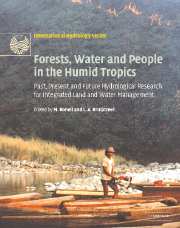 Forests, Water and People in the Humid Tropics
Forests, Water and People in the Humid Tropics Book contents
- Frontmatter
- Contents
- List of contributors
- Foreword
- Preface
- Acknowledgements
- Symposium and Workshop
- Introduction
- Part I Current trends and perspectives on people–land use–water issues
- Part II Hydrological processes in undisturbed forests
- Part III Forest disturbance, conversion and recovery
- Part IV New methods for evaluating effects of land-use change
- Part V Critical appraisals of best management practices
- Conclusion: Forests, water and people in the humid tropics: an emerging view
- Plate section
Part V - Critical appraisals of best management practices
Published online by Cambridge University Press: 12 January 2010
- Frontmatter
- Contents
- List of contributors
- Foreword
- Preface
- Acknowledgements
- Symposium and Workshop
- Introduction
- Part I Current trends and perspectives on people–land use–water issues
- Part II Hydrological processes in undisturbed forests
- Part III Forest disturbance, conversion and recovery
- Part IV New methods for evaluating effects of land-use change
- Part V Critical appraisals of best management practices
- Conclusion: Forests, water and people in the humid tropics: an emerging view
- Plate section
Summary
SUMMARY
This section contains four chapters providing a critical assessment of existing guidelines (also called best management practices) that have been designed to minimise adverse effects on soils and streams during timber harvesting and land clearing operations in areas with tropical forest, as well as under rainfed cropping in deforested tropical steeplands. In addition, the main factors hampering the widespread application of these best management practices are examined in some detail and areas indicated requiring additional research.
Cassells and Bruijnzeel provide an overview of guidelines aiming to minimise adverse impacts on the residual vegetation, soils and streams during tropical timber harvesting operations. Research and land management experience over many decades have demonstrated that poorly planned or managed logging operations generally have deleterious environmental impacts. Most commonly, logging and the associated road construction lead to problems with erosion and sedimentation, and thus to a reduction in the quality of streamwater and aquatic habitat. At the same time, there is considerable evidence indicating that, provided forest managers and planners respect broad land capability limits, appropriately managed logging operations can be compatible with the maintenance of good quality water supplies. In this regard, experience has shown that particular attention needs to be given to the careful location of roads, extraction trails and stream crossings; minimising ground disturbance and maintaining effective ground cover; as well as maintaining undisturbed buffer strips (as stressed by Connolly and Pearson; Hamilton) around key streams and waterways.
- Type
- Chapter
- Information
- Forests, Water and People in the Humid TropicsPast, Present and Future Hydrological Research for Integrated Land and Water Management, pp. 837 - 839Publisher: Cambridge University PressPrint publication year: 2005


